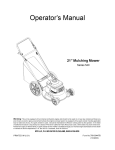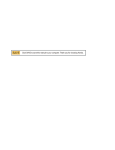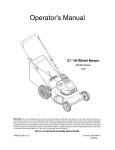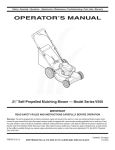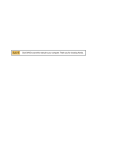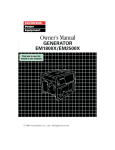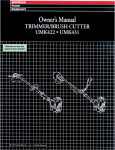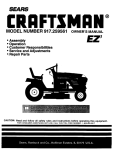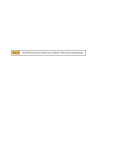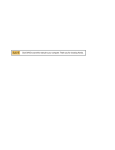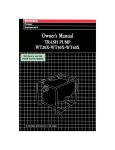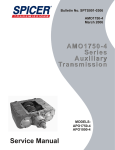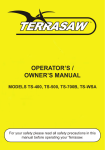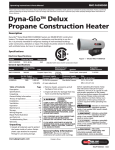Download Honda WH15X/WH20X User's Manual
Transcript
The engine exhaust from this product contains chemicals known tothe State of California to cause cancer, birth defects or other reproductive harm. Keep this owner’s manual handy,so you can refer toit a t any time. Thisowner’smanual is considered a permanent part of the water pump and should remain with the water pump resold. if The information and specifications included in this publication were in effect a t thetimeofapprovalforprinting. Honda Motor Co., Ltd. reserves the right, however,to discontinue or change specifications or design at any time without notice and without incurring any obligation whatever. No partofthispublicationmay be reproducedwithout written permission. Congratulations on your selection of a Honda water pump. Weare certain you will be pleased with your purchase of one of the finest water pumps on the market. We want to help you get the best results from your new water pump and to operate it safely. This manual contains the information on how to dothat; please read it carefully. As ou read this manual, you will find information preceded by a symbol. That informationisintendedtohelpyouavoid damage to your water pump, other property, or the environment. We suggestyou read thewarrantypolicytofullyunderstand its coverage and your responsibilities of ownership. The warranty policy is a separate document that should have been given to you by your dealer. When your water pump needs scheduled maintenance, keep in mind thatyourHondaservicing dealer is speciallytrained in servicing Honda water pumps. YourHonda servicingdealer is dedicated to your satisfactionandwill be pleased to answeryourquestionsand concerns. Best Wishes, Honda Motor Co., Ltd. 1 INTRODUCTION A FEW WORDS ABOUT SAFETY Your safety and the safetyof others are very important. And using this water pump safely is an important responsibility. To help you make informed decisions about safety, we have provided operatingproceduresandotherinformationon labelsand inthis manual. This information alerts you to potential hazards that could hurt you or others. Of course, it is not practical or possible to warn you about all the hazards associated with operating or maintaining a water pump. You must use your own good judgment. You willfindimportant including: 0 safety informationin a varietyofforms, Safety Labels - on the pump. 8.and one Safety Messages - preceded by a safety alert symbol of three signal words,DANGER, WARNING, or CAUTION. These signal words mean: You WILL beKILLED or SERIOUSLYHURT if you don‘t follow instructions. You CANbeKILLED or SERIOUSLYHURT you don’t follow instructions. if You CAN be HURT ifyoudon’tfollow instructions. Safety Headings - such as IMPORTANTSAFETYINFORMATION. Safety Section - such as PUMP SAFETY 0 Instructions - how touse this pump correctly and safely. This entire book is filled with important safety information - please read it carefully. 2 PUMP SAFETY ........................................................................................... IMPORTANT SAFETY INFORMATION ................................................. SAFETY LABEL LOCATIONS................................................................. 5 5 7 CONTROLS COMPONENT & CONTROL LOCATIONS............................................. 8 CONTROLS ............................................................................................. 9 Fuel Valve Lever ................................................................................. 9 Ignition Switch.................................................................................... 9 Choke Lever ...................................................................................... 10 Throttle Lever ................................................................................... 10 Recoil Starter Grip ............................................................................ 11 BEFORE OPERATION .............................................................................. ARE YOU READY TO GET STARTED?................................................ IS YOUR PUMP READY TOGO? ......................................................... Check the General Condition of the Pump..................................... Check the Suction andDischarge Hoses ........................................ Check the Engine .............................................................................. 12 12 13 13 14 14 OPERATION ............................................................................................. SAFE OPERATING PRECAUTIONS .................................................... PUMP PLACEMENT ............................................................................. SUCTION HOSE INSTALLATION ........................................................ DISCHARGE HOSE INSTALLATION ................................................... PRIMING THE PUMP ............................................................................ STARTING THE ENGINE ..................................................................... SETTING ENGINESPEED .................................................................... STOPPING THE ENGINE ..................................................................... 15 15 16 17 18 18 19 21 22 SERVICING YOUR PUMP ........................................................................ THE IMPORTANCE OF MAINTENANCE ............................................. MAINTENANCE SAFETY ..................................................................... MAINTENANCE SCHEDULE ............................................................... REFUELING ........................................................................................... FUEL RECOMMENDATIONS .............................................................. ENGINE OIL LEVEL CHECK ................................................................. ENGINE OIL CHANGE .......................................................................... ENGINE OIL RECOMMENDATIONS ................................................... 24 24 25 26 27 28 29 30 31 3 CONTENTS SERVICING YOUR PUMP (continued) AIR FILTER INSPECTION ..................................................................... AIR FILTER CLEANING ........................................................................ SEDIMENT CUP CLEANING ................................................................ SPARK PLUG SERVICE ........................................................................ IDLE SPEED ADJUSTMENT ................................................................ SPARK ARRESTER SERVICE (optional equipment) .......................... STORAGE ................................................................................................. STORAGE PREPARATION ................................................................... Cleaning ............................................................................................ Fuel .................................................................................................... Engine Oil .......................................................................................... STORAGE PRECAUTIONS .................................................................. REMOVAL FROM STORAGE ............................................................... TRANSPORTING ...................................................................................... TAKING CARE OF UNEXPECTED PROBLEMS...................................... ENGINE ................................................................................................. Engine Will Not Start ....................................................................... Engine Lacks Power ......................................................................... PUMP .................................................................................................... No Pump Output .............................................................................. Low Pump Output ............................................................................ 32 33 34 35 37 38 39 39 39 40 43 43 44 45 46 46 46 46 47 47 47 TECHNICAL & CONSUMER INFORMATION ......................................... 48 TECHNICAL INFORMATION ................................................................ 48 48 Serial Number Location ................................................................... ...................49 Carburetor Modification for High Altitude Operation 50 Oxygenated Fuels ............................................................................ Emission Control System Information ........................................... 51 Air Index ............................................................................................ 53 54 Specifications ................................................................................... CONSUMER INFORMATION ............................................................... 58 58 Honda Publications .......................................................................... Customer Service Information ........................................................ 59 QUICK REFERENCE INFORMATION ............................ Inside back cover PUMP SAFETY IMPORTANT SAFETY INFORMATION Honda WH15X and WH20X pumps are designed to pump only water that is not intended for human consumption, and other uses can result in injury to the operator or damage to the pump and other property. Most accidents can be prevented if you follow all instructions in this manual and on the pump. The most common hazards are discussed below, along with thebest way toprotect yourselfand others. Operator Responsibility It is the operator’s responsibility to provide the necessary safeguards to protect people and property. Knowhow tostop the pump quickly in case of emergency. If you leave the pump forany reason, always turn the engineoff. Understand the use of all controls and connections. Be sure thatanyonewho operates thepump receives proper instruction. Do not let children operate the pump. Keep children and pets awayfrom thearea of operation. Pump Operation Pumponlywaterthatisnotintendedforhumanconsumption. Pumping flammable liquids,such as gasoline or fueloils, can result in a fireor explosion,causingserious injury.Pumping sea water, beverages, acids, chemical solutions, or any other liquid that promotes corrosioncan damagethe pump. Refuel With Care Gasoline is extremely flammable, and gasoline vapor can explode. Refuel outdoors, in a well-ventilatedarea, with theengine stopped and the pump on a level surface. Do not fill the fuel tank above the fuel strainer shoulder. Never smoke near gasoline, and keep other flames and sparks away. Always storegasoline in anapprovedcontainer. Make sure that any spilled fuel has been wiped up before starting the engine. 5 PUMP SAFETY Hot Exhaust The muffler becomes very hot during operation and remains hot for a while after stopping the engine. Be careful not to touch the muffler while it is hot. Let the engine cool before transporting the pump or storing it indoors. To prevent fire hazards, keep the pump a t least 3 feet ( 1 meter) away from building walls and other equipment during operation. Do not place flammable objectsclose to theengine. Carbon Monoxide Hazard Exhaust gas contains poisonous carbon monoxide. Avoid inhalation of exhaust gas. Never run the engine in a closed garage orconfined area. PUMP SAFETY SAFETY LABEL LOCATIONS The labels shown here contain important safety information. Please read them carefully. These labels are considered permanent parts of your pump. If a label comes off or becomes hard to read, contact an authorized Honda servicing dealerfor a replacement. r WARNINGDO NOT PUMP FLAMMABLE OR CORROSIVEMATERIALS. ANEXPLOSION OR FIRE COULD RESULT, CAUSING \SEVERE PERSONAL INJURY. , PUMP CAUTION LABEL 7 CONTROLS COMPONENT & CONTROL LOCATIONS < WHZOX> CARRYING HANDLE FUEL FILLER CAP MUFFLER THROTTLE LEVER CHOKE LEVER FUEL VALVE LEVER STARTER GRIP OIL DRAIN PLUG PRIMING WATER FILLER CAP -- 8 PUMP DRAIN PLUG CONTROLS CONTROLS Fuel Valve Lever The fuel valve opens and closes theconnectionbetweenthefuel tank and thecarburetor. FUEL VALVE LEVER , , I, The fuel valvelever must be in the ON position for the engine run. to Whentheengineisnot in use, leave the fuel valve lever in the O F Fp o s i t i o nt op r e v e n t carburetor flooding and toreduce the possibility of fuel leakage. Ignition Switch IGNITION SWITCH The ignitionswitchcontrolsthe ignition system. The ignition switch mustbe in the ON position for the engine to run. Turning the ignition switch to the OFF position stops theengine. 9 CONTROLS Choke Lever The choke lever opens and closes the choke valvein the carburetor. CHOKE LEVER I The CLOSED position enriches the fuel mixture for startinga cold engine. -- The OPEN positionprovidesthe cL correct fuel .mixture for operation after starting, and for restarting a warm engine. Throttle Lever The throttle lever controls engine speed. Movingthethrottle lever inthe directions shown makes the engine runfaster or slower. Pump output is controlled by adjusting the throttle lever. At maximumthrottleposition,the pumpwilldeliverthehighest o u t p uvt o l u m eM . o v i n gt h e throttle lever toward the idle position will decrease the output volume of the pump. 10 THROTTLE LEVER CONTROLS Recoil Starter Grip Pulling the starter grip operates the recoil starterto crank the engine. STARTER GRIP 11 BEFORE OPERATION ARE YOU READY TO GET STARTED? Your safety is your responsibility. A little time spent in preparation will significantly reduce your risk of injury. Knowledge Read and understand this manual. Know what the controls do and how to operate them. Familiarize yourself with the pump andits operation before you begin pumping. Know what to do case in of emergencies. Be sure of what you are pumping. This pump is designed to pump only water thatis not intended for human consumption. 12 BEFORE OPERATION IS YOUR PUMP READY TO GO? For your safety, and to maximize theservice life of your equipment,it is very important to take a few moments before youoperate the pump to check its condition.Be sure to take care of any problem youfind, or have your servicingdealer correct it, before youoperate the pump. Improperly maintaining this pump, or failing to correct aproblem before operation, couldcause a malfunction in which you could be seriously injured. Always performa preoperation inspection before each operation, and correct any problem. Exhaust gas contains poisonous carbon monoxide. Avoid inhalation of exhaust gas. Never run the engine a in closed garageor confinedarea. To prevent fire hazards, keep the pump a t least 3 feet (1 meter) away from building walls and other equipment during operation. Do not place flammable objects closeto the engine. Before beginning your preoperation checks, be sure the pump is ona level surface and the ignition switch is in the OFF position. Check the General Conditionof the Pump 0 0 0 Look around and underneath the pump for signs of oil or gasoline leaks. Remove any excessive dirt or debris, especially around the engine muffler, and recoil starter. Look for signs of damage. Check that all nuts, bolts, screws, hose connectors and clamps are tightened. 13 Check the Suction andDischarge Hoses Check the general condition of the hoses. Be sure the hoses are in serviceable condition before connecting them to the pump. Remember that the suctionhose must be reinforced construction to prevent hose collapse. Check that the sealing washer in the suction hose connector is in good condition(see page 17 ). Check that the hose connectors and clamps are securely installed (see pages 17 & 18 ). Check that the strainer is in good condition and is installed on the suction hose (see page 17 ). Check the Engine Check the oil level (see page 29 ). Running the engine with a low oil level cancause engine damage. Check the air filter(see page32 1. A dirty air filterwill restrict air flow to thecarburetor, reducing engine and pump performance. Check the fuel level (see page27 ). Starting with a full tank will help to eliminate or reduce operating interruptions for refueling. 14 SAFE OPERATING PRECAUTIONS To safely realize the full potential of this pump, you need a complete understanding of its operation and a certain amount of practice with its controls. Before operating thepumpforthefirst time, please reviewthe IMPORTANT SAFEN INFORMATION on page 5 and the chapter titled BEFORE OPERA TION. For your safety, avoid starting or operating the engine in an enclosed area, such as a garage. Your engine’s exhaust contains poisonous carbon monoxide gas which can collect rapidly in an enclosed area and cause illness ordeath. Pumponlywaterthatisnotintendedforhumanconsumption. Pumping flammable liquids,such as gasoline or fueloils, can result in a fireor explosion,causingserious injury.Pumping sea water, beverages, acids, chemical solutions, or any other liquid that promotes corrosion can damage the pump. 15 OPERATION PUMP PLACEMENT For best pump performance, place the pumpnear the water level, and usehoses that are no longer than necessary. That will enable the pump toproduce the greatest output with theleast self-priming time. As head (pumpingheight) increases, pumpoutput decreases. Maximumhead specificationsand pump performancecurves are shown in the tables on pages 55 and 57. The length, type, and size of the suction and dischargehoses can also significantly affect pump output. Discharge head capability is always greater than suction head capability, so it is important forsuction head to be the shorter part of total head. Minimizing suction head (placing the pump near the water level) is also very important for reducing self-priming time. Self-priming time is the timeit takes the pumpto bring water thedistance of the suction head during initial operation. 16 OPERATION , SUCTION HOSE INSTALLATION Use thecommerciallyavailablehoseandhoseconnector with the hose clampprovided with thepump. Thesuctionhosemustbe reinforced with a noncollapsiblewall or braided wire construction. The suction hose should be no longer than necessary. Pump performance is best when the pump is near the water level, and the hoses are short. Use a hose clamp tosecurely fasten the hose connectorto the suction hose in order to prevent air leakage and loss of suction. Verify that the hose connector sealing washer in is good condition. Install the strainer (provided with the pump) on the other end of the suction hose, and secure it with a hose clamp. The strainerwill help to prevent the pump from becoming clogged or damaged debris. by Securely tighten thehose connector on the pump suction port. SUCTION PORT SEALING WASHER HOSE CLAMP RING (commercially available) SUCTION HOSE (commercially available) i ! CONNECTOR HOSE CLAMP 17 OPERATION DISCHARGE HOSEINSTALLATION Use a commercially available hoseandhoseconnector,and clamp provided with the pump. HOSE CONNECTOR (com/mercially available) DISCHARGE HOSE It is best t o use a short, large-diameter hose, because that will reduce fluid friction and improve pumpoutput. A longor smalldiameter hose will increase fluid friction andreduce pump output. Tighten the hose clamp securely topreventthedischarge hose from disconnecting under high pressure. HOSE CLAMP PRIMING THE PUMP Beforestartingthe engine,remove thefillercapfromthepump chamber, and completely fill the pump chamber withwater. Reinstall the fillercap, and tightenit securely. I NOTICE I Operating the pump dry willdestroy the pump seal. If the pump has been operated dry, stop the engine immediately, and allow the pump to cool before priming. PRIMING WATER FILLER CAP 18 OPERATION STARTING THE ENGINE 1. Prime the pump(see page 18 ). 2. Move the fuel valve lever to theON position. FU-ELVALVE LEVER 3. To start acold engine, move thechoke lever to theCLOSED position. To restart a warm engine, leave the choke lever in the OPEN position. CHOKE LEVER 4. Move the throttle lever away from the SLOW position, about 1/3 of the way toward the FAST position. THROTLE LEVER 19 OPERATION 5. Turn the ignition switch to the ON position. , IGNITION SWITCH 6. Pull thestarter grip lightly untilresistance is felt, then pullit briskly. Do not allow thestarter grip tosnap back against the engine. Return it gently to prevent damage the to starter. STARTER GRIP 20 OPERATION 7. If the choke lever was moved to the CLOSED position to start the engine, gradually moveit to theOPEN position as the engine warms UP. SETTING ENGINE SPEED After starting the engine, move the throttle lever to the FAST position for self-priming, andcheck pump output. Pumpoutputiscontrolledbyadjustingengine speed. Moving the throttle lever in the FAST direction will increase pump output,and moving the throttle lever in the SLOW direction will decrease pump output. THROlTLE LEVER 21 OPERATION STOPPING THE ENGINE To stop the enginein an emergency, simply turn the ignition switch to Under normal conditions, use the following the OFF position. procedure. 1. Move the throttle lever to SLOW the position. THROlTLE LEVER 2.Turn the ignition switch to the OFF position. u! I IGNITION SWITCH 22 _-I I , OPERATION 3. Turn the fuelvalve leverto theOFF position. / FUEL. VALVE LEVER OFF After use, remove the pump drain plug (see page40 ), and drain the pump chamber. Remove the filler cap, and flush the pump chamber with clean, freshwater.Allow the watertodrainfromthepump chamber, then reinstall the fillercap and drain plug. 23 SERVICING YOUR PUMP THE IMPORTANCE OF MAINTENANCE Good maintenance is essential for safe, economical, and trouble-free operation. Itwill also help reduce airpollution. ' Improperly maintaining this pump, or failure to correct a problem before operation,can cause a malfunction in which you can be seriously hurt or killed. Always follow the inspection and maintenance recommendations and schedules in this owner's manual. To help you properly care for your pump, the followingpages include a maintenance schedule, routine inspection procedures, and simple maintenance procedures using basic hand tools. Other service tasks that are more difficult, or require special tools, are best handled by professionals and are normally performed by a Honda technician or other qualified mechanic. The maintenance schedule applies to normal operating conditions. If you operate your pump under severe conditions, such as sustained high-load or high-temperature operation, or use in unusually wet or dusty conditions, consult your servicing dealer for recommendations applicable to your individual needs anduse. Remember that your servicing dealer knows your pump best and is fully equipped to maintain and repair it. To ensurethebestqualityandreliability, use only new, genuine Honda parts ortheir equivalents for repair and replacement. Maintenance, replacement, or repair of emission control devices and systems may be performed by any engine repair establishment or individual, using parts that are "certified" t o EPA standards. SERVICING YOUR PUMP MAINTENANCE SAFETY Some of the most important safety precautions follow. However, w e cannotwarnyouofevery conceivable hazard that can arise in performing maintenance.Only you candecidewhether or not you should performa giventask. Failure to properly follow maintenance instructions and precautions can cause you to be seriously hurt orkilled. Always followthe procedures and precautions in the owner's manual. Safety Precautions Make sure the engine is off before you begin any maintenance or repairs. This will eliminate several potential hazards: -Carbon monoxide poisoning from engineexhaust. Be sure there is adequate ventilation whenever you operate the engine. -Burns from hotparts. Let the engine and exhaust system cool before touching. -Injury from moving parts. Do not run the engine unless instructedto doso. 0 0 Read the instructions before you begin, and make sure you have the tools andskills required. To reduce thepossibilityoffireor explosion,becareful when workingaround gasoline. Use only a nonflammable solvent, not gasoline, to clean parts. Keep cigarettes, sparks, and flames away from allfuel-related parts. 25 SERVICING YOUR PUMP MAINTENANCE SCHEDULE Emission-related items. (1) Service more frequently whenused in dusty areas. (2) These itemsshouldbeserviced by your servicing dealer, unless you have the proper tools and are mechanically proficient. Refer t o Honda shop manual forservice procedures. (3) For commercial use, log hoursofoperationtodetermineproper maintenance intervals. 26 SERVICING YOUR PUMP REFUELING Fuel tank capacities WH15X: 0.66 US gal (2.5 !2,0.55 Imp gal) WH20X: 0.95 US gal (3.6 2! ,0.79 Imp gal) With the engine stopped, remove the fuel tankcap and check the fuel level. Refillthe tank if the fuel level is low. Gasoline is highly flammable and explosive. You can be burned orseriously injured when handling fuel. Stop the engine and keep heat, sparks, and flameaway. Handle fuel only outdoors. Wipe up spills immediately. 27 SERVICING YOUR PUMP Refuel in a well-ventilated area before starting theengine. If the engine has been running,allow it to cool. Refuel carefully to avoid spilling fuel. Do not fill the fuel tank above the fuelstrainer shoulder. After refueling, tighten the fuel tank cap securely. Never refuel the engine inside a building where gasoline fumes may reach flames or sparks. Keep gasoline away fromappliance pilot lights, barbecues, electric appliances, power tools, etc. Spilled fuel is not onlya fire hazard, it causes environmental damage. Wipe up spills immediately. Fuel can damage paint and plastic. Be careful not to spill fuel when filling your fuel tank. Damage caused b y spilled fuel is not covered under warranty. FUEL RECOMMENDATIONS Use unleaded gasoline with a pumpoctane rating of 86 or higher. These engines are certifiedto operate on unleaded gasoline. Unleaded gasoline produces fewer engine and spark plug deposits and extends exhaust system life. Never use stale or contaminated gasoline or an oil/gasoline mixture. Avoid gettingdirt or water in the fuel tank. Occasionally youmay heara light "spark knock" or"pinging" (metallic rapping noise) while operating under heavyloads. This is no cause for concern. Ifsparkknock or pinging occurs at a steadyengine normal load, change brands of gasoline. If spark knock persists, see an authorized Honda servicing dealer. speed, under or pinging Running the engine with persistent spark knock or pinging can cause engine damage. Running the engine with persistent spark knock or pinging is misuse, and the Distributor's Limited Warrantydoes not cover parts damaged by misuse. 28 SERVICING YOUR PUMP ENGINE OIL LEVEL CHECK Check theengineoil position. level with the engine stopped and in alevel 1. Remove the oil fillercap/dipstick andwipe it clean. 2. Insert and remove the dipstick without screwing it into the fillerneck. Check the oillevel shown onthe dipstick. 3. If the oil level is low, fill to the edge of the oil filler hole with the recommended oil(see page 31 ). 4. Screw in the oil fillercap/dipstick securely. OIL FILLER NECK \ UPPER LIMIT OIL FILLER CAP/DIPSTICK pfiZ7 Running the engine with a low oillevel can causeengine damage. 29 SERVICING YOUR PUMP ENGINE OIL CHANGE Drain the used oil while the engine is warm. Warm oil drains quickly and completely. 1. Place a suitable container below the engine to catch the used oil, then remove the oil filler cap/dipstick and the drain plug. 2.Allow the used oil to drain completely, then reinstall the drainplug, and tightenit securely. Please dispose of used motor oil in a manner that is compatible with the environment. Wesuggest you take used oil in a sealed container to your local recycling center or service station for reclamation. Do not throwit in the trash,pour it on the ground,or downa drain. 3. With the engine in a level position, fill to the outer edge of the oil filler hole with the recommended (see oil page 31 ). Engine oil capacity: 0.63 US qt (0.60 0, 0.53 Imp qt) Running the enginewith a low oillevel can causeengine damage. 4. Screw in the oil filler cap/dipstick securely. OIL LEVEL I DRAIN PLUG OIL FILLER CAP/DIPSTICK 30 SERVICING YOUR PUMP ENGINE OIL RECOMMENDATIONS Oil is a major factor affecting performance and service life. Use 4-stroke automotive detergent oil. SAE IOW-30 is recommendedfor general use. Other viscosities shown in the chart may be usedwhen theaverage temperature in yourarea is wit.hin the recommendedrange. SAE Viscosity Grades -30 -20 -1 0 0 10 20 30 4OoC AMBIENT TEMPERATURE The SAE oil viscosity and service classification are in the API label on the oil container.Hondarecommends thatyou use API SERVICE category SJ oil. The recommended operating range of this pump is23 O F to 104 O F (-5 OC to 40 "C). 31 I SERVICINGYOUR PUMP AIR FILTER INSPECTION Unscrew the wing nut and remove theair cleaner cover. Check the air filter tobe sureit is clean and in good condition. If the air filter is dirty, clean it as described on page 33. Replace the air filter ifit is damaged. Reinstall the air filter and air cleaner cover. Be sure all the parts shown below are in place. Tighten the wing nut securely. W I Operating the enginewithout an air filter, or with adamaged air filter, will allow dirt enter to theengine, causing rapid enginewear. This type of damage isnot covered by the Distributor's Limited Warranty. AIR CLEANER COVER COVER WASHER AIR FILTER GRID 32 SERVICING YOUR PUMP AIR FILTER CLEANING A dirty air filterwill restrict air flow to the carburetor, reducing engine performance. If you operate the pump in very dusty areas, clean the airfiltermorefrequentlythan specified in the MAINTENANCE SCHEDULE (see page 26 ). 1. Clean the air filter in warm soapy water, rinse, and allow to dry thoroughly. Or clean in nonflammable solvent and allow to dry. 2. Dip the air filter in clean engine oil, then squeeze out all excess oil. The engine will smoke when started if too much oil is left in the foam. 3. Wipe dirt from the air cleaner base and cover, using a moist rag. Be careful to prevent dirt from entering the carburetor. 33 ' SERVICINGYOUR PUMP ~ SEDIMENT CUP CLEANING 1. Move the fuel valvelever to the OFF position, then remove the fuel sediment cup and O-ring. Gasoline is highly flammable and explosive. You can be burned orseriously injured when handling fuel. Stop the engine and keep heat, sparks, and flameaway. Handle fuel only outdoors. Wipe up spills immediately. 2. Wash the sediment cup and O-ring in nonflammable dry them thoroughly. solvent, and 3. Place the O-ring in the fuel valve, and install the sediment Tighten the sediment cup securely. cup. 4. Move the fuel valve lever to the ON position, and check for leaks. Replace the O-ring if there is any leakage. O-RING 34 SERVICING YOUR PUMP SPARK PLUG SERVICE In order to service the spark plug, you will need a spark plug wrench (commercially available). Recommended spark plug:BPR6ES (NGK) W20EPR-U(DENSO) Incorrect spark plugs can causeengine damage. 1. Disconnect the spark plug cap, and remove any dirt from around the spark plug area. 2. Remove the spark plug witha 13/16-inch spark plug wrench. SPARK PLUG WRENCH 3. Inspect the spark plug. Replace it if theelectrodes are worn, or if the insulatoris cracked or chipped. Clean the spark plug with a wire brush if youare going toreuse it. 0.028-0.031 in (0.70-0.80 rnrn) i I ~ 4. Measure the spark plug electrode gap witha suitable gauge. Correct the gap, if necessary, by c a r e f u l l yb e n d i n gt h es i d e electrode. The gap shouldbe: 0.028-0.031 in (0.70-0.80 mm) 5. Install the spark plug carefully, by hand, t o avoid cross-threading. 35 ~ SERVICING YOUR PUMP 6.Afterthe spark plug seats, tightenwith wrench to compress the washer. If reinstalling the used spark plug seats. a 13/16-inch spark plug sparkplug, tighten 118-1/4 turn after the If installing a new spark plug, tighten 1/2 turn after the spark plug seats. A loose spark plug can overheat anddamage the engine. Overtighteningthe spark plug can damage thethreads cylinder head. 7. Attach thespark plug cap. 36 in the SERVICING YOUR PUMP IDLE SPEEDADJUSTMENT 1. Start the engine outdoors, and allow temperature. it to warm up to operating pEiGl Dry operation will damage the pump seal.Be sure thepump chamber is filled with water before starting the engine. 2. Move the throttle lever to its slowest position. 3. Turn the throttle stop screw to obtain the standard speed. idle Standard idlespeed: 1,400 ?% rpm THROlTLE STOP SCREW 37 SERVICING YOUR PUMP SPARK ARRESTER SERVICE(optional equipment) Your engine is not factory-equipped with a spark arrester. In some areas, it is illegal to operate an engine withouta spark arrester. Check local laws and regulations. A spark arrester is available from authorized Honda servicingdealers. Thesparkarrester mustbe functioning as designed. servicedevery 100 hoursto keep it If the enginehas been running, the mufflerwill be very hot. Allow the muffler to cool before servicing the spark arrester. 1. Remove thetwo 8 mm nuts, and remove the muffler. 2. Remove the four5 mm self-tapping screws, and remove the muffler protector from the muffler. 3.Remove the 4 m m screw from the spark arrester, and remove the spark arresterfrom the muffler. 5 rnrn SELF-TAPPING MUFFLER PROTECTOR 4 rnrn SCREW SPARK ARRESTER 4. Use a brush t o remove carbon deposits from thespark arrester screen. Be careful to avoid damaging thescreen. The spark arrester must be free of breaks and holes. Replace thesparkarresterif it is damaged. SPARK ARRESTER SCREEN 5. Installthe spark arrester, muffler protector, andmufflerinthe reverse order ofdisassembly. 38 STORAGE PREPARATION Proper storage preparation is essential for keeping yourpump troublefree and looking good. The following steps will help to keep rust and corrosion from impairing your pump's function and appearance, and will make the engineeasier to start when you use the pump again. Cleaning 1. Wash the engineand pump. Wash the engine by hand, and be careful to prevent water from entering the air cleaner or muffler opening. Keep water away from controlsandallother places that are difficultto dry, as water promotes rust. I NOTICE 1 0 0 Using a garden hose or pressure washing equipment can force water into the air cleaner or muffler opening. Water in the air cleaner will soak the air filter, and water that passes through the air filter or muffler can enter the cylinder, causing damage. Water contacting a hot engine can cause damage. If the engine has been running, allow it to cool for atleast half an hour before washing. 2. Wipe dry allaccessible surfaces. 3. Fill the pump chamber with clean, fresh water, start the engine outdoors, and let it run until it reaches normal operating temperature to evaporate any external water. 1Dry operation will damage the pump seal. Be sure the pump chamber is filled withwater before starting theengine. 39 STORAGE 4. Stop the engine, and allow it to cool. 5. Remove the pump drain plug, and flush the pump with clean, fresh water. Allow the water to drain from the pump chamber, then reinstall the drain plug. 6. After the pump is clean and dry, touchup any damaged paint, andcoat areas thatmayrust with a light film of oil. Lubricate controls with a siliconespray lubricant. PUMP DRAIN PLUG Fuel Gasoline will oxidizeanddeteriorateinstorage.Oldgasoline will cause hardstarting,and it leaves gumdepositsthatclogthefuel system. If the gasoline in your engine deteriorates during storage, you may need to have the carburetor and other fuel system components serviced or replaced. The length of time that gasoline can be left in your fuel tankand carburetor without causing functional problems will vary with such factors as gasoline blend, your storage temperatures, and whether the fuel tank is partially or completely filled.The air in a partially filled fuel tank promotesfueldeterioration. Very warmstorage/temperatures accelerate fuel deterioration. Fuel deterioration problems may occur within a few months, or evenless if the gasoline was not fresh when you filled the fuel tank. The Distributor'sLimitedWarranty does notcoverfuelsystem damageorengineperformanceproblemsresultingfromneglected storage preparation. Youcan extend fuel storage life by adding a fuel stabilizer that is formulatedforthatpurpose,oryou can avoidfueldeterioration problems by draining the fuel tank and carburetor. I STORAGE Adding a Fuel Stabilizer to Extend Fuel Storage Life When adding a fuel stabilizer, fill the fuel tank with fresh gasoline. If onlypartially filled, airinthe tank will promotefueldeterioration during storage. If you keep a container of gasoline for refueling, be sure that it contains only freshgasoline. 1. Add fuelstabilizer following themanufacturer’s instructions. 2. After addinga fuel stabilizer, run the engine outdoors for 10 minutes to be sure that treated gasoline has replaced the untreated gasoline in thecarburetor. pmq Dryoperation will damage the pump seal. Be surethe chamber is filled withwater before starting the engine. pump 3. Stop theengine, and move the fuel valve lever to theOFF position. / OFF FUEL VALVE LEVER 41 STORAGE Draining the Fuel Tank and Carburetor 1. Place an approved gasoline container below the carburetor, and use a funnel to avoid spilling fuel. 2. Remove the carburetor drain bolt and sedimentcup, then move the fuel valve lever to the ON position. Gasoline is highly flammable and explosive. You can be burned or seriously injured when handling fuel. Keep heat, sparks, and flame away. Handle fuel only outdoors. Wipe up spills immediately. DRAIN BOLT SEDIMENT' CUP 3.After all the fuel has drained into the container, reinstall the drain bolt and sedimentcup. Tighten themsecurely. 42 STORAGE Engine Oil 1. Change the engine oil(see page30 ). 2. Remove the spark plug (see page 35 ). 3. Pour a tablespoon(5- 10 cc) ofclean engine oil into the cylinder. 4. Pull the starter grip several times to distribute the oil in thecylinder. 5. Reinstall the spark plug. 6.Pull the starter grip slowly until resistance is felt and the notch on the starter pulley aligns with the hole at the top of the recoil starter cover. Thiswill close the valves so moisture cannot enter the engine cylinder. Return the starter grip gently. Align notch onpulley with hole at topof cover. STORAGE PRECAUTIONS Ifyourpumpwill bestoredwithgasolineinthefueltank and carburetor, it is important to reduce the hazard ofgasolinevapor ignition. Select a well-ventilated storagearea away from anyappliance that operates with a flame, such as a furnace, water heater, or clothes dryer. Also avoid any area with a spark-producing electric motor, or where power toolsare operated. If possible, avoidstorage areas with highhumidity, promotes rust and corrosion. because that Unless all fuelhas been drainedfrom the fuel tank, leave the fuel valve lever in theOFF position toreduce the possibility of fuel leakage. 43 STORAGE Place the pump ona level surface. Tilting can cause fuel or oilleakage. With the engine and exhaust system cool, cover the pump tokeep out dust. A hotengineandexhaustsystem can igniteormeltsome materials. Do not use sheet plastic as a dust cover. A nonporous cover will trap moisture around the pump, promoting rust and corrosion. REMOVAL FROMSTORAGE Check your pump as described in theBEFORE OPERATIONchapter of this manual. If the fuel was drained during storage preparation, fill the tank with be fresh gasoline. If you keep a container of gasoline for refueling, surethat it containsonlyfreshgasoline.Gasoline oxidizesand deteriorates over time, causing hard starting. If the cylinder was coated with oil during storage preparation, the engine may smoke briefly at startup. Thisis normal. 44 TRANSPORTING If the pump has been running, allow the engine to cool forat least 15 minutesbeforeloadingthepump on thetransport vehicle. A hot engineandexhaustsystem can burnyouand can ignitesome materials. Keep the pump level when transporting to reduce the possibility of fuel leakage. Move the fuel valve lever to theOFF position. 45 TAKING CARE OF UNEXPECTED PROBLEMS ENGINE Engine Will Not Start 1. Check control positions. Possible Cause Fuel valve OFF. Correction Move fuel valve lever to ON position. Move choke lever to CLOSED position unless engine is warm. Turn ignition switch to Choke open. Ignition switchOFF. 2. Check fuel. 3. Remove and inspect spark plug. fuel. of Out Bad fuel; pumpstored without treating or draining gasoline, or refuel with bad gasoline. Spark plug faulty, fouled, or improperly gapped. Spark plug wet with fuel (flooded engine). 4. Take engine to an authorized Honda servicing dealer, or refer to shopmanual. Engine Lacks Power 1. Check air filter. 2. Check fuel. 3. Take engine to an authorized Honda servicing dealer, or refer to shop manual. 46 Fuel filter clogged, carburetor malfunction, ignition malfunction, valves stuck, etc. Possible Cause Air filter clogged. Bad fuel; pump stored without treating or draining gasoline, or refuel with bad gasoline. Fuel filter clogged, carburetor malfunction, ignition malfunction, valves stuck, etc. I I ON. ~ ~ _ _ _ Refuel (p. 27 Drainfueltankand carburetor (p. 42 ). Refuel with fresh gasoline (p. 27 ). Clean, gap, or replace spark plug (p. 35 ). Dry and reinstallspark plug. Start engine with throttle lever inFAST position. Replace or repair faulty components as necessary. Correction Clean or replace filter (P. 33 1. Drain fuel tank and carburetor (p. 42 ). Refuel with fresh gasoline (p. 27 ). Replace or repair faulty components as necessary. TAKING CARE OF UNEXPECTED PROBLEMS PUMP No Pump Output 1. Check pump chamber. 2. Check suction hose. Possible Cause Pump not primed. Hose collapsed, cut or punctured. Strainer not completely underwater. I Air leak at connector. I Strainer clogged. Correction Prime pump(p. 18 ) Replace suction hose (P. 17 1. Sink the strainer and the end ofa suction hose completely underwater. Replace sealing washer if missing ordamaged. Tighten hose connector and clamp(p. 17 1. Clean debris from strainer. Relocate pump and/or hoses to reduce head (p. 16,55,57 ). 3. Measure suction and discharge head. Excessive head. 4. Check engine. Engine lacks power. See page 46. Low Pump Output 1. Check suction hose. Possible Cause Hose collapsed, damaged, too long, or diameter too small. Air leak at connector. Correction Replace suction hose (p. 17 ). Strainer clogged. 2. Check discharge hose. hose 3. Measure suction and discharge head. 4. Check engine. Hose damaged, too long, or diameter too small. Marginal head. lacks power. Replace sealing washer if missing or damaged. Tighten hose connector and clamp (p. 17 1. Clean debris from strainer. Replace discharge (p. 18 1. Relocate pump and/or hoses to reduce head (p. 16, 55, 57 ). See page 46. Engine 47 TECHNICAL & CONSUMER INFORMATION TECHNICAL INFORMATION Serial Number Location <WH20X > ENGINE SERIAL NUMBER Record the engineserial number in thespace below. Youwill need this serial number when ordering parts, andwhenmakingtechnical or warranty inquiries(see page 59). Engine serial number: 48 TECHNICAL & CONSUMER INFORMATION Carburetor Modification for High Altitude Operation At high altitude, the standard carburetor air-fuel mixture will be too rich. Performance will decrease, and fuel consumption willincrease. A very rich mixture will also foul the spark plug and cause hard starting. Operation at an altitude that differs from that at which this engine was certified, for extended periods of time, may increase emissions. High altitude performance can be improved by specific modifications to the carburetor. If you always operate your pump at altitudes above 5,000 feet (1,500 meters), have your servicing dealer perform this carburetor modification. Thisengine, when operated a t high altitude with thecarburetormodificationsforhighaltitude use, will meet each emission standard throughout its useful life. Even with carburetor modification, engine horsepower will decrease about 3.5% for each1,000-foot (300-meter) increase in altitude. The effect ofaltitudeonhorsepower will begreater thanthisifno carburetor modification ismade. W I When the carburetor has been modified for high altitude operation, the air-fuel mixture will be toolean for low altitudeuse. Operation at altitudes below 5,000 feet (1,500 meters) with a modified carburetor may cause the engineto overheat and result in serious engine damage. Foruse atlow altitudes, have yourservicing dealer returnthe carburetor to originalfactory specifications. 49 I TECHNICAL & CONSUMERINFORMATION Oxygenated Fuels Some conventional gasolines are being blended with alcohol or an ether compound. Thesegasolines are collectivelyreferredto as standards, some areas ofthe oxygenated fuels. To meetcleanair United States and Canadause oxygenatedfuelstohelpreduce emissions. If you use an oxygenated fuel, be sure it is unleaded and meets the minimum octane rating requirement. Before using an oxygenated fuel, try to confirm the fuel‘s contents. Some states/provinces require this information to be posted on the pump. The following are the EPA-approved percentages of oxygenates: ETHANOL MTBE ~ (ethyl or grain alcohol) 10% by volume You may use gasoline containing up to 10% ethanol byvolume.Gasolinecontainingethanolmay be marketed under the name “Gasohol”. (methyl tertiary butyl ether) 15% by volume You may use gasoline containing up to15% MTBE by volume. METHANOL -(methyl or wood alcohol) 5% by volume You may use gasoline containing up to5% methanol by volume as long as it also contains cosolvents and corrosioninhibitorstoprotectthefuelsystem. Gasolinecontainingmorethan 5% methanolby volume may cause starting and/or performance problems.Itmay alsodamagemetal,rubber,and plastic parts of your fuel system. If you notice any undesirable operating symptoms, try another service station, or switch to another brand gasoline. of Fuel system damage or performance problems resulting from the use of an oxygenatedfuelcontainingmorethanthepercentagesof oxygenates mentioned aboveare not covered under warranty. 50 TECHNICAL & CONSUMER INFORMATION Emission Control System Information Source of Emissions The combustion process produces carbon monoxide, oxides of nitrogen, and hydrocarbons. Control of hydrocarbons and oxides of nitrogenisveryimportant because, undercertainconditions, they react to formphotochemical smog whensubjected to sunlight. Carbon monoxide does not react in thesame way, but it is toxic.. Honda utilizes lean carburetor settings and other systems the emissions of carbon monoxide, oxides of nitrogen, hydrocarbons. to reduce and The U.S. and California Clean Air Acts EPA andCaliforniaregulationsrequire allmanufacturers to furnish written instructionsdescribing the operation and maintenance of emission control systems. The following instructions and procedures must be followed in order to keep the emissions from your Honda engine within the emission standards. Tampering andAltering Tampering with or altering the emission control system may increase emissions beyond the legal limit. Among those acts that constitute tampering are: 0 0 Removal or alteration of any part of the systems. Alteringordefeatingthegovernor mechanism to cause theengineto parameters. intake, fuel, or exhaust linkage or speed-adjusting operateoutside itsdesign 51 ' TECHNICAL & CONSUMER INFORMATION Problems That May Affect Emissions If you are aware of any of the following symptoms,have your engine inspected and repaired by your servicing dealer. Hard starting or stalling after starting. Rough idle. Misfiring or backfiring underload. Afterburning (backfiring). 0 Black exhaust smoke or high fuel consumption. Replacement Parts The emission control systems on your Honda engine were designed, built,andcertifiedtoconformwith EPA andCaliforniaemission regulations. We recommend the use of genuine Honda parts whenever you have maintenance done. These original-design replacement parts are manufactured to the samestandards as the original parts, so you can be confident of their performance. The use of replacement parts that are not of the original design and quality may impair the effectiveness of your emission control system. A manufacturer of an aftermarket part assumes the responsibility that the part will not adversely affect emission performance. The manufacturer or rebuilder of the part must certify thatuse of the part will not result in a failure of the engine to comply with emission regulations. Maintenance Follow the maintenance schedule on page 26 . Remember that this schedule is based on the assumption that your machine will be used foritsdesignedpurpose.Sustainedhigh-loadorhigh-temperature operation, or use in unusually wet or dusty conditions, will require more frequentservice. 52 TECHNICAL & CONSUMER INFORMATION Air Index An Air Index Information hang tag/label is applied to engines certified durability time period in accordance with the t o an emission requirements ofthe California Air Resources Board. The bar graph is intended to provideyou, our customer, the ability to compare the emissions performance of available engines. The lower the AirIndex, the less pollution. The durability description is intended to provide you with information relating to the engine’s emissiondurabilityperiod. Thedescriptive term indicates the useful-life period for the engine’s emission control system. See your EmissionControlWarranty foradditional information. Descriptive Term Applicable to Emission Durability Period Moderate 50 hours (0-65 cc) 125 hours (greater than65 cc) Intermediate 125 hours (0-65 cc) 250 hours (greater than65 cc) Extended 300 hours (0-65 cc) 500 hours (greater than65 cc) The Air Index Information hang tag must remain on the pump untilit is sold. Removethe hang tag before operating the pump. 53 TECHNICAL & CONSUMER INFORMATION Specifications WH15X Dimensions and weight 16.3 in (415 m m ) 14.2 in (360 mm) 15.9 in (405 m m ) 49 Ibs (22 kg) Length Height Dry weight Width Engine design and performance I Model Engine type Displacement [bore X stroke] Maximum torque Cooling system Ignition system PTO shaft rotation I GX120K1 I I Tuneup Spark plug gap Idle speed Valve clearance (cold) Other specifications 54 1 4-stroke, overhead valve, single cylinder 7.3 cu-in (119 cc) [2.4 X 1.7 in (60 X 42 m m ) ] 3.9 bhp (2.9 kW, 4.0 PS) at 4,000 rpm Maximum output 5.4 ft-lb (7.4 N.rn, 0.75 kg-rn) at 2,500 rpm Forced air Transistorizedmagneto Counterclockwise 0.028 - 0.031 i n See page 35. (0.70-0.80 m m ) 1,400 rpm See page 37. Intake:0.15 k 0.02 mm See shop 0.20 k 0.02 mm manual. Exhaust: No other adjustments needed. 2: TECHNICAL & CONSUMER INFORMATION WH15X (continued) 'ump Suction port diameter Discharge port diameter Total head (maximum) Suction head (maximum) Discharge capacity (maximum) Self-priming time Continuous running time I 1 I 1.5 in (38 mm) 1.5 in (38mm) 164ft (50 m ) 26.2 ft (8 m) 105.7 US gal (400 !2,88.0Imp gal) Der minute 40 seconds at 16.4 ft (5m ) Approximately 2 hours (actual time varies with DumD load) Pump performancecurve As total head increases, discharge capacity decreases. The following graph shows the relationship between pump discharge capacity and total head, while pumping clear water atsea level. 164 131 3I 98 a c 66 33 (Q/min) (US g a l h i n ) DISCHARGE CAPACITY 55 TECHNICAL & CONSUMER INFORMATION WH20X Dimensions and weight 17.1 i n (435 m m ) 14.8 in (375 m m ) 15.7 i n (400 mm) 51.8 Ibs (23.5 kg) Length Width Height Dry weight Engine design and performance Model Engine type Displacement [bore X stroke] Maximum output Maximum torque Cooling system GX160K1 4-stroke, overhead valve, single cylinder 9.9cu-in (163 cc) [2.7 X 1.8 in (68 X 45 m m ) ] 5.4 bhp (4.0 kW, 5.5 PS)at 4,000 rpm 8.0 ft-lb (11 N-m, 1.Ikg-m) at2,500 rpm Forced air Transistorized magneto Ignition system Counterclockwise PTO shaft rotation Tuneup I Spark plug gap Idle speed Valve clearance (cold) 56 I 0.028-0.031 i n I See page 35. (0.70-0.80 m m ) 1,400 rpm See page 37. Intake: 0.15 -t 0.02 m m See shop manual. Exhaust: 0.20 k 0.02 mm No other adjustmentsneeded. Other specifications 2:: TECHNICAL & CONSUMER INFORMATION WHPOX (continued) Pump 1 Suction port diameter Discharge port diameter Total head (maximum) Suction head (maximum) Discharge capacity (maximum) Self-priming time Continuous running - time I 2 in (50 mm) 2 in (50 m m ) 164ft (50 m) 26.2 ft (8m) 132.1 US gal (500 0, 110.0 Imp gal) per minute 60 seconds at 16.4 ft (5m) Approximately 2-1/10 hours (actual time varies with pump load) Pump performance curve As total head increases, discharge capacity decreases. The following graph shows the relationship between pump discharge capacity and total head, whilepumping clear water at sea level. (ft) (m) 164 131 3 I 98 -I 2 ? 66 33 0 loo 200 26.4 52.8 79.3 I I 300 I 700 600 500 400 (Q/min) 105.7 132.1 158.5 184.9 (US gallmin) I I I I DISCHARGE CAPACITY 57 TECHNICAL & CONSUMER INFORMATION ~~ CONSUMER INFORMATION Honda Publications These publications will give you additional information for maintaining and repairing your pump.You may order them from your Honda pump dealer. Shop Manual This manual covers complete maintenance and overhaul procedures. It is intended tobe used bya skilled technician. Parts Catalog This manual provides complete, illustrated parts lists. 58 TECHNICAL & CONSUMER INFORMATION Customer Service Information Servicing dealership personnelare trained professionals. They should be able to answer any question you may have. If you encounter a problem that your dealer does not solve to your satisfaction, please discuss it with the dealership's management. The Service Manager or General Manager can help. Almost all problems are solved in this way. If you are dissatisfied with the decision madebythe management, contact the Honda Power Equipment Customer Relations Office. You can write: dealership's American Honda Motor Co., Inc. Power Equipment Division Customer Relations Office 4900 Marconi Drive Alpharetta, Georgia 30005-8847 Or telephone: (770)497-6400 When you write or call, please give us this information: Model andserial number (see page48 ) 0 Name of the dealer who sold the pump to you 0 Name and address of the dealer who services your pump 0 Date of purchase 0 Your name, address, and telephone number 0 A detailed descriptionof the problem 59 MEMO 60 QUICK REFERENCE INFORMATION Fuel Engine Oil Spark Plug Carburetor Maintenance ueder U! palU!Jd (IH) 90’100z’0001 0 @ @ OOzL-LaA- LEX00 OZLLaAlE LN
































































